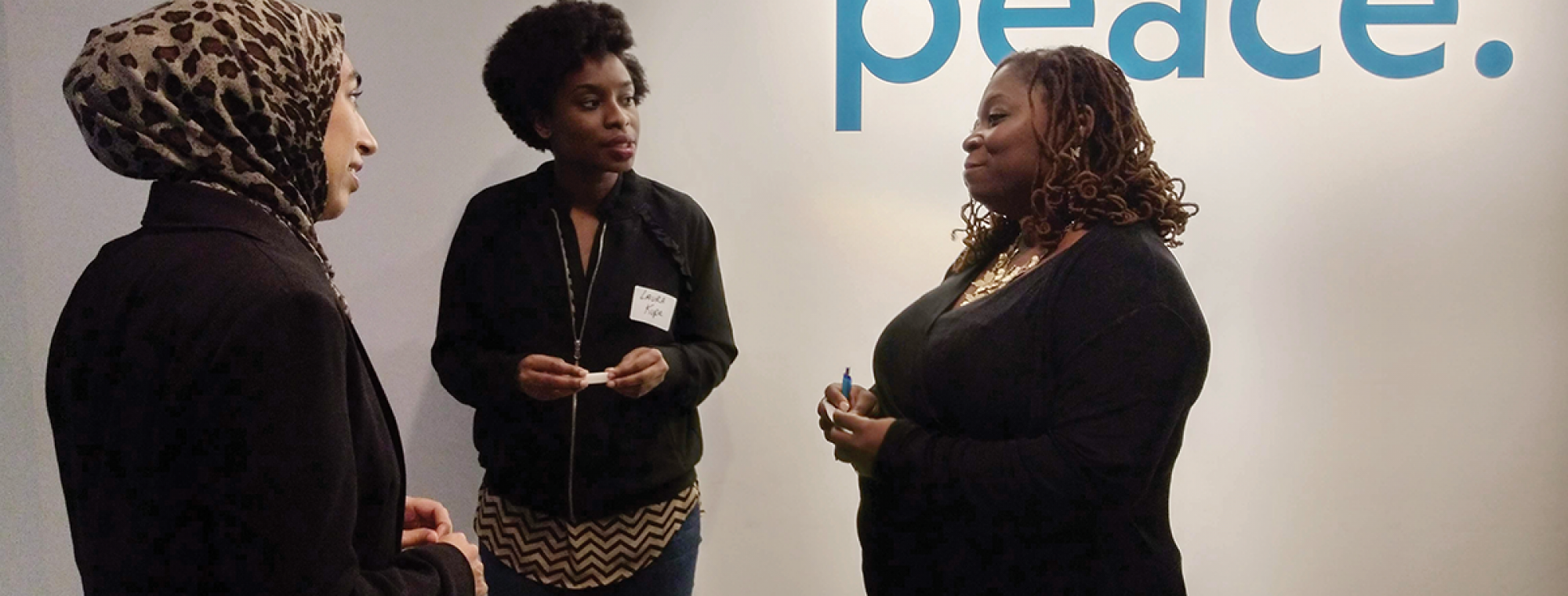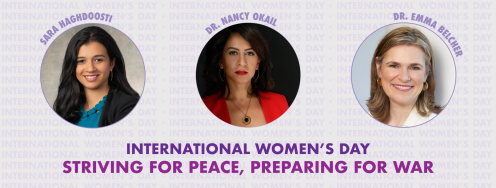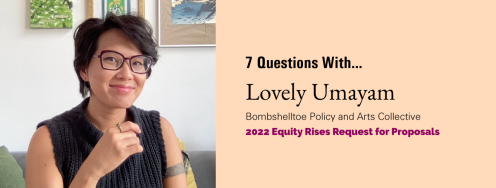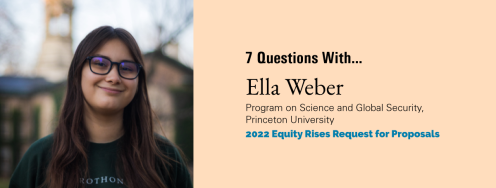By Ambassador Bonnie Jenkins
At a time when our global challenges are more complex than ever, it is particularly unfortunate that the decisionmaking levers of foreign and security policy do not reflect the rich diversity of cultures and perspectives that make up the United States.
US foreign and security policy is predominantly decided upon in governmental meeting rooms. While not inside government, other institutions that impact policymaking, such as think tanks and nongovernmental organizations (NGOs), traditionally provide input into these deliberations through direct engagement with government officials, conferences, op-eds and Track II meetings. As we deal with increased global security issues like climate change, infectious disease and the threat of weapons of mass destruction proliferation, decisionmakers must have the best and brightest at the table. Policymaking institutions, and those that impact policy, benefit from increased diversity of viewpoints, which have proved to lead to better decisions. Think tanks, one of those institutions, must have a process that both brings in and is inclusive of diverse voices throughout the organization. The question is, how do we create that diversity?
Why Does It Matter and What Is the Scope of the Problem?
A more diverse workforce is important to improving US foreign and security policy decisionmaking and outcomes.1 While the United States has an extraordinary array of cultures and perspectives, it is not leveraging its wealth of diverse talents.2 It has also become clear that the number of women and people of color in decisionmaking positions in foreign and security policies remains significantly underdeveloped.3 Brookings Institution, in a bold step, released demographic data related to staffing.4 It indicated how few fellows and senior fellows are women and people of color, and how they aim to do better.5 Hopefully this will set a trend of self-reporting by think tanks since accurate data helps increase our understanding of the challenges to diversifying organizations.
For me, the problem and solutions are personal. I have spent my career in policymaking positions, both inside and outside the US government. As Ford Foundation’s program officer for US foreign and security policy, it was clear based on grantee responses that many organizations, including think tanks, were not doing enough to diversify their boards, leadership and professional staff.6 I was interested in the leadership levels of organizations, like think tanks, which appeared to be particularly challenged in the area of diversity.7 After meeting those interested in diversity, I decided to focus on think tanks to learn what some of the challenges were and ways for those institutions to increase diversity. These experiences taught me two important realities. One, such institutions were not thinking strategically about how diversity would benefit them; two, they were not considering how to create an effective diverse pipeline of individuals entering the fields of foreign and security policy.
With this in mind, I followed my desire to empower young women of color, the demographic most impacted by peace and security policies. I wanted to promote their education and exposure to these issues, bring light to often hidden figures working in these fields and engage organizations to bring these women into leadership positions. Thus, in 2017, I founded Women of Color Advancing Peace, Security and Conflict Transformation (WCAPS).
I center my efforts on the two pathways for increasing diversity in foreign policy establishments: institutions and individuals. Recent levels of interest in the value of inclusion in the foreign and security policy space is more widespread and accepted than it was when I started in this field, which is a positive step. But to ensure the foreign policy field has access — and is listening — to the best policy ideas and decisions, we must do more to increase the numbers of women and people of color in professional and leadership roles and make those efforts more sustainable.
Institutions: Fostering Diversity, Equity and Inclusion (DEI)
Long-term diversity programs that recruit and maintain talent will create more diverse foreign policy establishments. Yet successful programs are more than just recruiting new talent. Before program creation, change must start at the top. Institutional leadership must be clearly committed to the goals of DEI. Those in leadership roles should delineate the importance of diversity, set objectives of a diversity plan and be clear on steps for implementation. Practically speaking, an organization should create a strategic plan for the sustainability of DEI efforts. It should address long-term goals, what the organization seeks to achieve in a specific time frame and how the leadership will measure success. To ensure accountability, a dedicated individual or a diverse group should meet regularly to review the organization’s processes, as well as successes and failures.
An important goal, though it is not always articulated, is to change an organization’s culture, which may be resistant. Change is uncomfortable. Staff can easily let new DEI initiatives become a low priority if there is no direction, because they want to protect their comfortable environment. In these situations, a leader must make decisions requiring immediate action that, if maintained through successive leaderships, will be sustainable and result in positive change.
Organizational process steps are not the only requisite for making such change, however. Part of an inclusive organizational culture is making people feel welcome. The diverse talent brought into an organization should not bear the burden of changing the organization. Those not from the predominant culture can tell whether an organization accepts and wants them to be part of the makeup. If these individuals do not feel welcome, the new talent will leave for a more welcoming environment.
One way to encourage a culture that welcomes diversity is to promote regular discussions on the topic of inclusion, between both the leadership and the staff. Culture is created through shared understandings of the world around us. Engaging staff in discussions on inclusion will help individuals become more comfortable with difficult conversations that many of us would otherwise actively avoid. Organizations should offer annual trainings on topics like unconscious bias and preventing sexual harassment, to assist and supplement these conversations as they evolve. They should be tailored to the specific needs of the organization and its personnel.
Finally, active pipeline maintenance is crucial to keeping these talented people in the field. Think tanks should consider how they can turn internships and fellowships into stable, paid positions. This makes it more likely that women and people of color entering the field as interns can remain. Where long- term employment is not possible, institutions can help them seek follow-on employment in places where the skills acquired at the think tank can be utilized.
Institutions should also require interns or fellows, regardless of demographic, to draft a development plan for advancement in the organization, to ensure career progression and satisfaction. It can match new diverse entrants with an experienced and senior-level person for support. That senior individual can serve as a mentor and sponsor, helping the new entrant navigate the organization and evaluate their career path. Fostering affinity groups as an additional support system for those who share a diverse background can also be helpful. Setting aside time for leadership and staff to gather outside the office so that individuals will get to know one another on a personal level is also important to building relationships and is key to better inclusion and acceptance.
It is essential that diversity be present at different levels within the organization, from the highest echelons of leadership to the most entry-level internships. Perception matters. Women and people of color want to see others like themselves in myriad roles, particularly in professional and leadership positions. Not only does this support a positive diverse culture, but organizations are more likely to attract a diverse pool of candidates from the outset if they can visibly show dedication to diversity.
Institutions must take ownership of the lack of diversity and inclusion in their leadership positions. Taking ownership starts at the top and includes a process and actions that ensure results. Ultimately, making such changes will help break down barriers for talented individuals, foster more inclusive and diverse organizations and subsequently form better policy.
Outreach: Engaging a Diverse Population
If think tanks are to increase diversity within professional and leadership positions, they must prepare the next generation to move into such roles. As a field and as individual institutions, they should consider how to reach young people of diverse backgrounds to interest them in issues like foreign and security policy and showcase this career path. Opening eyes to these areas even before college is essential. My own interest in public service goes as far back as junior high school, influencing early decisions about my education. While I was not sure what substantive area I would work, I knew where I wanted to be: in Washington, DC, working in the federal government. Institutions should recognize there are many students like this, who may not know how to pursue this career path.
Simultaneously, there must be a strategy for outreach to diverse populations at colleges and universities. Most think tanks have internships and fellowships for students and recent graduates. Such employments are the primary vehicle for bringing more diverse voices into organizations and populating the field’s pipeline. Recruitment for these positions must be a deliberate aspect of any outreach strategy. Fostering diversity begins much earlier in the process than decisions about which applicant to interview — institutions need to consider what networks are being tapped for applications, and whether the communities and places being reached are those from which they want to recruit talent.
Creating a solid applicant pool is more than sending out a position posting to an organization’s networks. Institutions should be very familiar with those they will engage. They should have an interesting message for different audiences, particularly those who do not necessarily connect foreign policy to their world or lived experience, given increasing discrimination challenges at home. In addition, paid internships and fellowships are critical. The applicant pool for positions in Washington, DC favors those who can afford to be in the District and work for little or no pay. If institutions seek a larger pool of diverse applicants, paying their interns and fellows will make such positions far more appealing and equitable.
Moreover, finding positions at think tanks is not a transparent process, particularly the farther away one is from Washington, DC Seeking prospective applicants at academic institutions is important but think tanks should also engage NGOs to share information with their memberships, youth programs and during outreach events. Building outreach relationships will help to bolster the pipeline. Organizations should create a regularly updated, easily accessed set of materials for prospective applicants about the application process, making it more likely they will remember such institutions when seeking placements.
Finally, organizations do not need to reinvent the wheel, especially given limited resources and time. There are already many resources for organizations to reach diverse and inclusive audiences. These include contact lists of women and people of color experts who can be engaged on foreign policy issues. Women In International Security (WIIS) is putting together a list of women professionals who may make good candidates for boards; WCAPS has a growing database of women of color in the fields of peace, security and conflict transformation to highlight the immense talent of young and midcareer women who can also serve on panels, are ready for media engagement and prepared for leadership positions; and Foreign Policy Interrupted and Women Also Know Stuff also both provide lists of female experts for engagement and outreach efforts.8
Conclusion
The global community is faced with increasing global threats; now more than ever foreign policy and security decisions need different perspectives. Current interest in more diverse, equitable and inclusive organizations within the Washington, DC landscape is important, but that interest must lead to actual changes that are sustainable over time. Incorporating more diverse staff and leadership at think tanks and other institutions is an effort that requires thoughtful leadership and dedication. Ensuring these become best practices, incorporated across the whole of the field — particularly within crucial policymaking institutions like think thanks — will lead to better decisions. This will summarily improve the overall policy of the United States by incorporating more individuals’ different perspectives, strengths and lived experiences in the process and subsequently the policies themselves.
Ambassador Bonnie Jenkins is the founder and president of Women of Color Advancing Peace, Security and Conflict Transformation (WCAPS) and a nonresident senior fellow at the Brookings Institution. Jenkins served as the Special Envoy and Coordinator for Threat Reduction Programs in the Bureau of International Security and Nonproliferation, US Department of State (DOS) under President Barack Obama from April 2009 to January 2017. She was the DOS lead for the 2010 — 2016 Nuclear Security Summits and the US Representative to the G-7 Global Partnership Against the Spread of Weapons and Materials of Mass Destruction. Before returning to government in 2009, Jenkins served as a program officer for US foreign and security policy at the Ford Foundation. Jenkins is a retired Naval Reserves officer and received several awards for her service.
This article is part of our new report, "A New Vision: Gender. Justice. National Security." See all the articles from our report here.
#Diversity makes better nuclear policy #NewVision2019.
Notes
1 Alex Johnson and Stefanie Brown James. “For Diplomacy That Looks Like the United States, Civil Society Must Lead by Example,” Open Society Foundations, September 28, 2018, https://www.opensocietyfoundations.org/voices/diplomacy-looks-united-states-civil-society-must-lead-example.
2 Victoria DeSimone, “Leveraging Diversity for Global Leadership,” Center for Strategic and International Studies, May 22, 2018, https://www.csis.org/analysis/leveraging-diversity-global-leadership.
3 According to Women in International Security (WIIS), women head only 27 percent of the national and international security think tanks, and only three of 22 think tanks have gender parity in their expert staff; “Gender Scorecard Initiative,” Women in International Security, accessed December 7, 2018, https://www.wiisglobal.org/ programs/gender-scorecard-initiative/.
4 John R. Allen. “A note from Brookings President John R. Allen on the release of our workforce demographic data,” The Brookings Institution, September 6, 2018, https://www.brookings.edu/blog/up-front/2018/09/06/a-note-from-brookings-president-john-r-allen-on-the-release-of-our-workforce-demographic-data/.
5 For example, 52 percent of the 444 full-time employees are women, and 32 percent are people of color. Yet among the fellows and senior fellows, only 34 percent are female and 22 percent are people of color.
6 I served as Ford Foundation’s Program Officer for US Foreign and Security Policy from 2005-2009.
7 The recently released Gender Scorecard Report notes several think tanks that are at or near 50 percent of women experts, such as Stimson Center, Nuclear Threat Initiative, and the United States Institute of Peace, and highlights existing programs by think tanks to increase the representation of women.
8 Women In International Security, accessed December 7, 2018, https://www.wiisglobal.org/; Women of Color Advancing Peace, Security and Conflict Transformation, accessed December 7, 2018, http://www.wcaps.org; Foreign Policy Interrupted, accessed December 7, 2018, http://www.fpinterrupted.com/; Women Also Know Stuff, accessed December 7, 2018, https://womenalsoknowstuff.com/.
Photo: Members of the WCAPS network. Photo credit: WCAPS.




